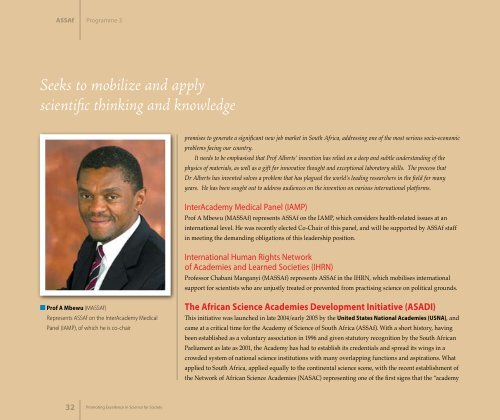Academy of Science South Africa 2005/6 Annual Report
Academy of Science South Africa 2005/6 Annual Report
Academy of Science South Africa 2005/6 Annual Report
- No tags were found...
You also want an ePaper? Increase the reach of your titles
YUMPU automatically turns print PDFs into web optimized ePapers that Google loves.
ASSAfProgramme 3Seeks to mobilize and applyscientific thinking and knowledgepromises to generate a significant new job market in <strong>South</strong> <strong>Africa</strong>, addressing one <strong>of</strong> the most serious socio-economicproblems facing our country.It needs to be emphasised that Pr<strong>of</strong> Alberts’ invention has relied on a deep and subtle understanding <strong>of</strong> thephysics <strong>of</strong> materials, as well as a gift for innovative thought and exceptional laboratory skills. The process thatDr Alberts has invented solves a problem that has plagued the world’s leading researchers in the field for manyyears. He has been sought out to address audiences on the invention on various international platforms.Inter<strong>Academy</strong> Medical Panel (IAMP)Pr<strong>of</strong> A Mbewu (MASSAf) represents ASSAf on the IAMP, which considers health-related issues at aninternational level. He was recently elected Co-Chair <strong>of</strong> this panel, and will be supported by ASSAf staffin meeting the demanding obligations <strong>of</strong> this leadership position.International Human Rights Network<strong>of</strong> Academies and Learned Societies (IHRN)Pr<strong>of</strong>essor Chabani Manganyi (MASSAf) represents ASSAf in the IHRN, which mobilises internationalsupport for scientists who are unjustly treated or prevented from practising science on political grounds.Pr<strong>of</strong> A Mbewu (MASSAf)Represents ASSAf on the Inter<strong>Academy</strong> MedicalPanel (IAMP), <strong>of</strong> which he is co-chairThe <strong>Africa</strong>n <strong>Science</strong> Academies Development Initiative (ASADI)This initiative was launched in late 2004/early <strong>2005</strong> by the United States National Academies (USNA), andcame at a critical time for the <strong>Academy</strong> <strong>of</strong> <strong>Science</strong> <strong>of</strong> <strong>South</strong> <strong>Africa</strong> (ASSAf). With a short history, havingbeen established as a voluntary association in 1996 and given statutory recognition by the <strong>South</strong> <strong>Africa</strong>nParliament as late as 2001, the <strong>Academy</strong> has had to establish its credentials and spread its wings in acrowded system <strong>of</strong> national science institutions with many overlapping functions and aspirations. Whatapplied to <strong>South</strong> <strong>Africa</strong>, applied equally to the continental science scene, with the recent establishment <strong>of</strong>the Network <strong>of</strong> <strong>Africa</strong>n <strong>Science</strong> Academies (NASAC) representing one <strong>of</strong> the first signs that the “academy32 Promoting Excellence in <strong>Science</strong> for Society









![National Research Foundation Annual Report 2008 / 2009 [Part 2]](https://img.yumpu.com/49774036/1/177x260/national-research-foundation-annual-report-2008-2009-part-2.jpg?quality=85)






